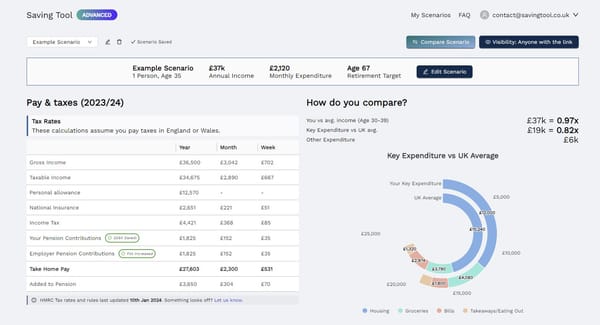Making sense of UK Umbrella Contract Rates
A deep-dive into rates and taxes when working through Umbrella companies

Since the IR35 rules were rolled out to the private sector around April 2021, the UK contracting market has seen a large expansion of inside-IR35 roles. Many companies (except those deemed small, typically under £10.2m turnover) take a cautious approach to avoid falling foul of the updated rules and determine most or all contract roles to fall within IR35.
Increasingly, 3rd party Umbrella companies are used to simplify the employment and liability of taxes and fundamentally avoid the complexities of IR35. Using an Umbrella essentially makes a contractor an employee (but technically employed by the Umbrella company) who gets paid via PAYE, but without a fixed annual salary.
In many cases, a contract role via an Umbrella company is paid using a day rate. But how does this day rate get taxed compared to outside-IR35 or permanent roles?
Existing contractors must manage expectations
It's important to understand that contracting via self-employment or a limited company is very different to contracting via an Umbrella. Contracting using a limited company (outside-IR35) in particular offers much more flexibility in terms of tax. Limited company directors often choose to split pay between salary and dividends - dividends have different allowances and tax rates to income, plus National Insurance contributions (NICs) are not payable on them.
Contracting using an Umbrella company is much more akin to being a permanent employee as you are paid via PAYE, paying income tax and NICs in the same way (no dividends are involved). This means that contracting using an Umbrella company does not benefit from any of the tax advantages that limited company directors can enjoy. In simpler terms, you pay more tax.
Contractors moving from a limited company to Umbrella should expect to take less home for the same day rate. But how much less?
How are day rates taxed using an Umbrella?
When you're an employee of the Umbrella company, the Umbrella company will operate a PAYE scheme to pay you. Unfortunately this means that there are "employer-side" deductions to pay before "employee-side" deductions like income tax.
A key factor in how much you are taxed is if your Umbrella company offers a salary sacrifice scheme for contributing to a Self-Invested Personal Pension (SIPP). Most Umbrella companies should offer this (often for a fee), and it represents an equivalent to an employer's defined Contribution (DC) pension scheme that you might expect to get as a permanent employee. Making contributions to a SIPP are strongly recommended for most people and typically, you will be able to choose an amount of your day rate that is sacrificed.
The very first deduction from your pay will be your salary sacrifice contribution to your SIPP (which reinforces the tax efficiency of making contributions, since neither employer-side or employee-side taxes apply to it).
First deduction:
- Your SIPP contribution (you retain 100% of this in your SIPP)
Second, "employer-side" deductions:
- Employer's National Insurance (the most significant employer-side cost at 13.8% of your day rate)
- Company Margin - paid to your Umbrella company to cover their costs
- Apprenticeship Levy - a small 0.5% HMRC tax
Finally, "employee-side" deductions:
- Income Tax
- Employee National Insurance Contributions (NICs)
- Umbrella fees
Sometimes, your Umbrella company may also be obliged to auto-enrol you into the NEST pension, which would apply to taxable earnings, i.e. after employer-side deductions. Although this is optional (you can opt-out), it typically (assuming NEST) results in an extra 3% uplift from your Umbrella, but requires a 5% contribution from you (relief at Source).
An example
Let's say you are on a day rate of £500 and have chosen to sacrifice £75 into your SIPP. We will also assume that your contract runs for 1 year, and you work 47 weeks - allowing 5 weeks for holidays, time off and public holidays.
We will also say that your Umbrella charges £25 per week as Company Margin, plus £8 per week Umbrella fees because you've opted-in to the SIPP option.
For simplicity, we will assume that you are opted out of auto-enrolment. Also, we will assume that Holiday Pay is paid in advance (see below for more information on holiday pay and sick pay).
Here is how the taxes would be calculated for 1 week (5 days worked):
- Gross Pay: £2,500
- SIPP Deduction: (£375)
- Remaining Pay: £2,125
- Employer's Side Deductions
- Employer's NI @ 13.8%: (£233)
- Company Margin @ £25: (£25)
- Apprenticeship Levy @ 0.05%: (£9)
- Total: (£267) - 12.5% deducted
- Remaining Pay: £1,858
- Employee's Side Deductions
- Income Tax: (£476)
- Employee's NI: (£80)
- Umbrella Fees: (£8)
- Total: (£564) - 30.4% deducted
- Remaining Pay: £1,294

Take-home Pay: £1,294 (61% after SIPP deduction, 69.6% after employer-side deductions)
Retained in SIPP: £375
Total retained: £1,669 (66.76% of gross pay / 33.24% effective tax rate).
A note on Holiday Pay and Sick Pay
A common source of confusion when considering an Umbrella role is how holiday pay works. Since you're taking employment, you are legally entitled to holiday (and sick) pay.
There are usually 2 options: allow it to accrue and request it when you wish, or have it all paid in advance.
In practice, in our view, it is only holiday pay by name: your umbrella company will use a calculation that splits your days worked revenue into regular pay/commission and holiday pay. Beware of being fooled into thinking you will get paid for any days not worked; holiday pay is simply a portion of the days you work. In simple terms, you do not get paid for days you do not work. Specifying a number of weeks worked during the year in the calculator (like 47 which allows for 5 weeks, including public holidays) is the way to account for this issue.
In the example above, the £1,858 received after SIPP and employer-side deductions will typically be split into Basic Pay, Commission and Holiday Pay, but still add up to £1,858. In practical terms, this technical splitting covers the Umbrella company legally for national minimum wage and holiday pay requirements, but makes no difference to you - you still end up with £1,858.
If you opt to have holiday pay accrue, there is a practical difference in that the holiday portion of this goes into a separate pot and you can request it separately (when you want to take holiday).
Note that, although you do not earn revenue on days not worked, you can optionally work more days/weeks to increase your income.
Sick pay is generally limited to Statutory Sick Pay, but this can vary by Umbrella company.
Comparing Umbrella rates to permanent roles
Using these inputs and calculations, you can figure out your take-home pay, annual pension contributions, plus "total compensation".
Total compensation is a commonly used term that can be thought of as: everything your employer pays you in 1 year, before tax. This usually ignores employer-side taxes, which are typically hidden away from employees (but a real cost to employers - due to employer's NI in particular, permanent employees always cost more than the "total compensation" number the employee will be familiar with).
In the case of an Umbrella contract calculating total compensation means totalling up the SIPP contributions and amount of pay left after employer-side deductions.
Using our example, that means: £375 SIPP + £1,858 Pay / week. Over 47 weeks, that equals around £104,944.
This means a 47-week £500 (£75 SIPP) contract would be worth the same as a permanent role that paid £87,319 in salary and £17,625 in pension contributions (or any other split where the total adds up to the same amount).
For a more practical example, this could be compared a permanent role that pays £97,000, with 10% employee and 8% employer pension contributions: this would equal £87,300 of salary and £17,460 of pension contributions (total £104,760).

After tax, both scenarios end up with pretty much the same amount (£60,818 with Umbrella example plus £17,625 SIPP vs £61,192 plus £17,460 Company Pension), since you are being taxed the same way, PAYE.
Tax and pension gotchas at higher levels
Contractors achieving higher rates should be aware of two common tax and pension gotchas - these apply to both permanent and Umbrella employees.
- The £100k tax trap - your personal allowance drops by £1 for every £2 your taxable income goes over £100k during the year, reaching £0 at £125,140. Depending on your income, it may be suitable to increase pension contributions to stay under £100k. If you are subject to a reduced personal allowance, the Saving Tool Umbrella Calculator will automatically adjust your taxes accordingly.
- The £260k pension tapering rules - your £60k pension contribution allowance will be reduced. These rules are a little complicated and independent financial advice is recommended, but the Saving Tool Umbrella Calculator will automatically warn you if it thinks you might be subject to it.
The Saving Tool UK income tax calculator will also automatically adjust for the personal allowance reduction over £100k, which can be useful when making comparisons.
Run your own Umbrella calculations today
With the UK market likely to see the continued use of Umbrella companies in the years ahead, it's important for contractors to stay informed and be equipped with the best tools to make decisions.
Visit the Saving Tool Umbrella Calculator to run your own calculations, available now.

Simply input a day rate, number of weeks worked, margin, fee and SIPP information and get an instant snapshot of your taxable pay, take-home pay, pension contributions and total compensation.

Also view a weekly/monthly/yearly breakdown, showing all deductions, take-home pay and pension contributions. Monthly and yearly outputs are based on the number of weeks that you work.





